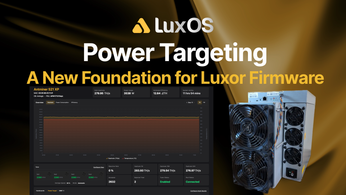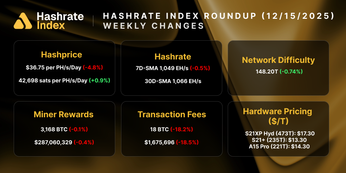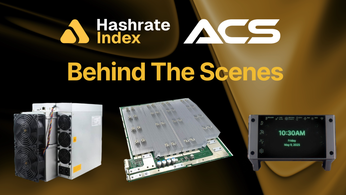
Intelligent Mining — Part 2: The Tech Stack Turning Signals Into Decisions
In this blog post, we cover two elements in the software stack that make intelligent mining possible: firmware and fleet management.
The Intelligent Miner — a new comprehensive guide published by Luxor Technology — introduces a fundamentally different approach to bitcoin mining operations. Download the full guide to learn how your operation can transition from binary to intelligent mining.
In Part I of this series, we explored the two markets that shape profitability —hashrate and energy — and how the most advanced operators now treat them as tradable commodities.
In Part II, we turn to two elements in the software stack that make this evolution possible: firmware and fleet management.
Firmware: The Machine's Operating System
Firmware is the foundation. Installed directly on a mining machine’s control board, firmware acts as its operating system — the brain that manages ASIC chip frequency, voltage, fan speeds, and thermals.
Most miners still rely on manufacturer stock firmware, which was designed for a bygone era of binary mining: machines run at full throttle until power costs force shutdowns. These systems offer no adaptability, no efficiency tuning, and no ability to interact with market signals.
Advanced third-party firmware solutions like LuxOS unlock granular control over machine performance parameters. These systems enable operators to adjust frequency settings, voltage levels, and thermal profiles to optimize for a range of goals — whether it's maximizing hashrate, minimizing power consumption, or finding profitability sweet spots in between.
Advanced firmware provides several critical capabilities for Intelligent Mining. Performance profiling allows custom configurations that balance hashrate output against power consumption based on changing market conditions. Thermal management enables automatic adjustments based on ambient temperature, humidity, and other environmental conditions. Most importantly for grid participation, advanced firmware enables rapid response capabilities, allowing machines to ramp performance up or down within seconds.
Individual machine intelligence is powerful, but it's not enough. Firmware systems must integrate with a higher-level management platform to enable fleetwide coordination. This allows individual machine capabilities to respect facility-level constraints while maintaining the flexibility to respond and reap the benefits of current market conditions and grid services.
Fleet Management: Facility-level Coordinator
If firmware is the brain of each miner, fleet management software is the nervous system that connects them all. It collects telemetry, interprets market data, and executes actions across thousands of machines simultaneously.
Fleet management software performs three essential functions:
- Configuration Management – Bulk operations such as firmware updates, pool switches, and performance profile adjustments across entire sites.
- Automation – Routine maintenance, failover, and reboot cycles executed automatically, minimizing human error and downtime.
- Monitoring – Real-time performance tracking at both the machine and facility level, including temperature, uptime, and environmental conditions.
For large-scale operations managing thousands of ASICs, these capabilities are indispensable. But Intelligent Mining goes a step further: modern fleet management platforms integrate directly with energy and hashrate markets.
This means fleets can automatically:
- Curtail load when energy prices spike or grid demand surges.
- Ramp up output when power is cheap or when Bitcoin transaction fees surge.
- Hedge exposure to hashprice volatility via integrated trading systems.
Through this stack, mining facilities become dynamic, multi-market participants—actively arbitraging between hashrate, power, and grid services in real time.

Together, advanced firmware and fleet management form the technological core of Intelligent Mining:
- Firmware provides the control.
- Fleet management provides the coordination.
- Market integration provides the signal.
The result is a system that can sense, decide, and act automatically — transforming mining from a static industrial refinement process into an active financial engine.
If you’d like to learn more about how to build your Intelligent Mining operation across Luxor’s full technology stack — including hashrate derivatives, firmware, and energy services — reach out to us at [email protected] or visit https://luxor.tech/energy.
About Luxor Technology Corporation
Luxor delivers hardware, software, and financial services that power the global compute and energy industry. Its product suite spans Bitcoin Mining Pools, ASIC Firmware, Hardware trading, Hashrate Derivatives, Energy services, and a bitcoin mining data platform, Hashrate Index.
Disclaimer
This content is for informational purposes only, you should not construe any such information or other material as legal, investment, financial, or other advice. Nothing contained in our content constitutes a solicitation, recommendation, endorsement, or offer by Luxor or any of Luxor’s employees to buy or sell any derivatives or other financial instruments in this or in any other jurisdiction in which such solicitation or offer would be unlawful under the derivatives laws of such jurisdiction.
There are risks associated with trading derivatives. Trading in derivatives involves risk of loss, loss of principal is possible.
Hashrate Index Newsletter
Join the newsletter to receive the latest updates in your inbox.







